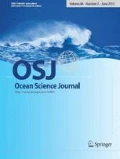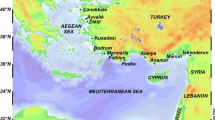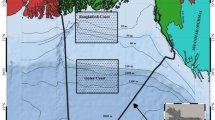Abstract
Satellite remotely sensed sea surface temperature (SST) was compared with in-situ SST in the seas around the Korean Peninsula from 1984 to 2013. A matchup dataset between satellite and in-situ SSTs was used. The root mean square error (RMSE) between satellite and in-situ SSTs was approximately 1°C in the offshore area and 2~3°C in the coastal area. The satellite SST exhibits a cold bias of 1°C or less in the offshore area and a warm bias of 1~3°C in the coastal area. The satellite SSTs generally agree with the in-situ data in the East/Japan Sea (EJS) better than in the South Sea and the Yellow Sea (YS). The RMSE between the two SSTs in the South Sea (SS) is 1~2°C. In-situ and satellite SST analyses respectively indicate a warming trend of 0.024°C/year and 0.011°C/year for the study period in the seas around the Korean Peninsula. The difference in the long-term trends from the two data sources is mainly due to the difference in the YS. The satellite SST showed a warm bias of 0.5~1.0°C in the early 1980’s and a cold bias of 0.5°C in the early 2010’s, which should be carefully considered in studying long-term trends with satellite SST data.
Similar content being viewed by others
References
Cho Y-K, Kim K (2000) Branching of the Tsushima Current in the Korea Strait. J Phys Oceanogr 30(11):2788–2797
Cho Y-K, Kim M-O, Kim B-C (2000) Sea fog around Korean Peninsula. J Appl Meteorol 39(12):2473–2479
Kim KR, Cho YK, Kang DJ, Ki JH (2005) The origin of the Tsushima Current based on oxygen isotope measurement. Geophys Res Lett 32(3):L03602, doi: 10.1029/2004GL021211
Lee MA, Chang YI, Sakaida F, Kawamura H, Cheng CH, Chan JW, Huang I (2005) Validation of satellite-derived sea surface temperatures for waters around Taiwan. Terr Atmos Ocean Sci 16(5):1189–1204
McClain EP, Pichel WG, Walton CC (1985) Comparative performance of AVHRR based Multichannel sea surface temperatures. J Geophys Res 90(C6):11609–11618
Min HS, Kim CH (2006) Interannual variability and long-term trend of coastal sea surface temperature in Korea. Ocean and Polar Res 28:415–423
Park KA, Chung JY, Kim K, Choi BH, Lee DK (1999) Sea surface temperature retrievals optimized to the East Sea (Sea of Japan) using NOAA/AVHRR Data. Mar Tech Soc J 33(1):23–35
Park KA, Chung JY, Kim K, Choi BH (1994) A study on comparison of satellite drifter temperature with satellite derived sea surface temperature of NOAA/NESDIS. J Korean Soc Remote Sens 11(2):83–107
Park KA, Sakaida F, Kawamura H (2008a) Oceanic skin-bulk temperature difference through the comparison of Satelliteobserved sea surface temperature and in-site measurements. Korean J Remote Sens 24(4):273–287
Park K-A, Sakaida F, Kawamura H (2008b) Error characteristics of satellite-observed sea surface temperatures in the Northeast Asian Sea. J Korean Earth Sci Soc 29(3):280–289
Park KA, Lee E-Y, Chung S-R, Sohn E-H (2011) Accuracy assessment of sea surface temperature from NOAA/AVHRR data in the seas around Korea and error characteristics. Korean J Remote Sens 27(6):663–675
Reynolds RW, Smith TM, Liu C, Chelton DB, Casey KS, Schlax MG (2007) Daily high-resolution blended analyses for sea surface temperature. J Clim 20:5473–5496
Sakaida F, Kawamura H (1992) Estimation of sea surface temperatures around Japan using the advanced very high resolution radiometer, (AVHRR)/NOAA-11. J Oceanogr 48(2):179–192
Seo G-H, Choi B-J, Cho Y-K, Kim YH, Kim S (2010) Assimilation of sea surface temperature in the Northwest Pacific Ocean and its marginal seas using the ensemble kalman filter. Ocean Sci J 45(4):225–241
Seo G-H, Cho Y-K, Kim C-S, Choi B-J, Shaha DC (2014) Variations of heat transport in the Northwestern Pacific marginal seas inferred from a high-resolution reanalysis. Prog Oceanogr 121:98–108
Strong A, McClain EP (1984) Improved ocean surface temperatures from space comparisons with drifting buoys. Bull Am Meteorol Soc 65(2):138–139
Sun Y-J, Cho Y-K (2010) Tidal front and its relation to the biological process in coastal water. Ocean Sci J 45(4):243–251
Author information
Authors and Affiliations
Corresponding author
Rights and permissions
About this article
Cite this article
Kwak, MT., Seo, GH., Cho, YK. et al. Long-term comparison of satellite and in-situ sea surface temperatures around the Korean Peninsula. Ocean Sci. J. 50, 109–117 (2015). https://doi.org/10.1007/s12601-015-0009-1
Received:
Revised:
Accepted:
Published:
Issue Date:
DOI: https://doi.org/10.1007/s12601-015-0009-1




